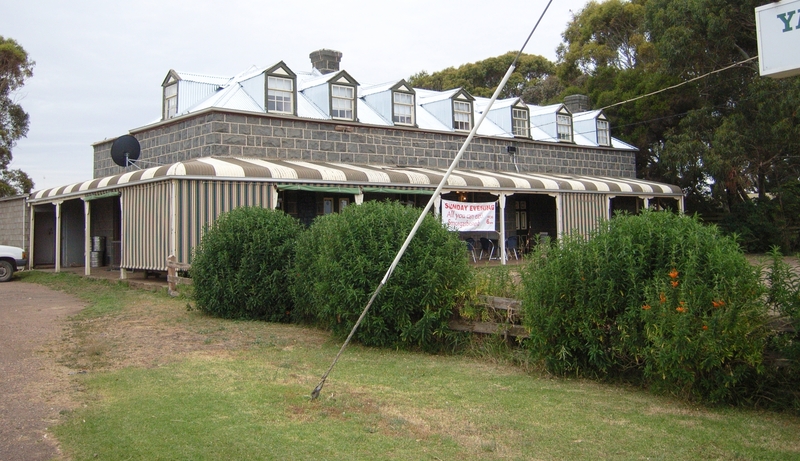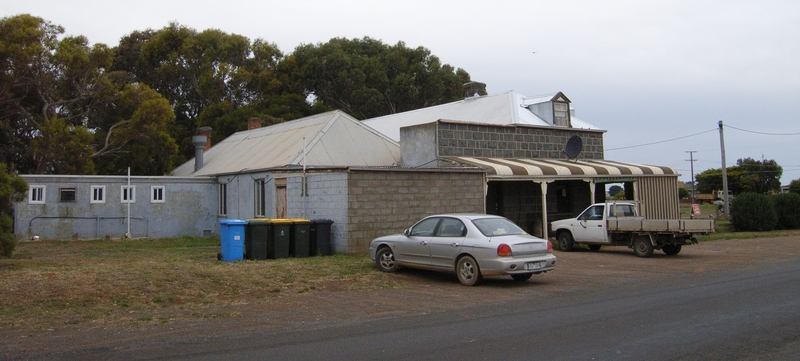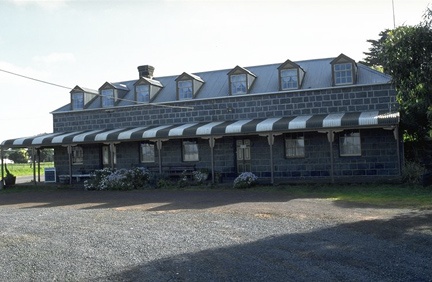YAMBUK INN
4218 PRINCES HIGHWAY YAMBUK, MOYNE SHIRE
-
Add to tour
You must log in to do that.
-
Share
-
Shortlist place
You must log in to do that.
- Download report




Statement of Significance
What is significant?
The Yambuk Inn stands on land which was originally part of the Yambuck pastoral run first taken up by Lieutenant Andrew Baxter in 1843 when Baxter and his wife Annie Baxter travelled overland from Port Macquarie to take up the run. By 1851, the run had passed into other hands but the Yambuck name remains primarily associated with Annie Baxter [later Annie Dawbin] who kept a remarkable diary while at the property which documents settler life and provides graphic accounts of clashes between local Kooris and European settlers in the district. The small township given the name of Yambuk which gradually developed on the Shaw River and beside Lake Yambuk providing an important stopping place for travellers between Port Fairy and Portland. A timber bridge spanned the Shaw River in the early years before a more permanent bridge was erected in 1856. The site of the hotel immediately outside the Yambuk township reserve was first purchased by Michael Cummins in 1855. In 1856, Cummins sold to Cornelius Carlin [sometimes Carolan] who erected a timber hotel on the site. John Kelly acquired the property from Cornelius Carlin in 1859 and Kelly is first recorded as applying for a publican's licence in the same year. In 1870-1871, Kelly built a new stone hotel to the design of by Port Fairy architect Captain John Mason, reputedly on the site of the previous timber building. John Mason played many roles in the life of Port Fairy, being at different times, an innkeeper, architect, estate agent, Captain of Militia and building contractor. As a builder, Mason constructed the Port Fairy post office in 1881.
James Kelly, however, appears to have over-extended himself financially and the mortgagees sold the property to Thomas J Coughlan [sometimes Coghlan] in 1872. In 1882, Coughlan applied to change the name from the Yambuk Inn to the Commercial Hotel but it appears that the hotel may have been operating under this name since at least 1875 when local doctors Lupton and McNamara offered consultations at the hotel on a regular basis. Like the previous owner Kelly, Coughlan eventually lost the hotel in financially difficult times when mortgagees foreclosed in 1897. The hotel has passed through a number of ownerships and publicans during the twentieth century but the building remained largely unchanged externally apart from the addition of a verandah of Edwardian appearance which runs across the front of the building. The hotel now carries the name of the Yambuk Inn, which has been the name of hotel for the majority of its life.
How is it significant?
The Yambuk Inn is of architectural and historical significance to the State of Victoria.
Why is it significant?
The Yambuk Inn of 1870-71 is of architectural significance for its distinctive one and half storey form and the late representation of the persistence of early Australian colonial vernacular tradition forms in regional Victoria. The attic roof structure is evocative of early building traditions in New South Wales and Tasmania and possibly reflects local taste or the provincial practices of the Port Fairy architect and builder John Mason. The hotel is one of few surviving examples of the work of John Mason, who played many roles in the life of Belfast, being at different times, an innkeeper, architect, estate agent, Captain of Militia and building contractor.
The Yambuk Inn is of historical significance for its representation of the importance of Yambuk as stopping place providing accommodation between Port Fairy and Portland since the early 1850s.
[Online data upgrade project 2005]
-
-
YAMBUK INN - History
The Yambuk Inn stands on land which was originally part of the Yambuck pastoral run first taken up by Lieutenant Andrew Baxter in 1843 when Baxter and his wife Annie Baxter travelled overland from Port Macquarie to take up the run. By 1851, the run had passed into other hands but the Yambuck name remains primarily associated with Annie Baxter [later Annie Dawbin] who kept a remarkable diary while at the property which documents settler life and provides graphic accounts of clashes between local Kooris and European settlers in the district. The small township given the name of Yambuk which gradually developed on the Shaw River and beside Lake Yambuk providing an important stopping place for travellers between Port Fairy and Portland. A timber bridge spanned the Shaw River in the early years before a more permanent bridge was erected in 1856. The site of the hotel immediately outside the Yambuk township reserve was first purchased by Michael Cummins in 1855. In 1856, Cummins sold to Cornelius Carlin [sometimes Carolan] who erected a timber hotel on the site. John Kelly acquired the property from Cornelius Carlin in 1859 and Kelly is first recorded as applying for a publican’s licence in the same year. In 1870-1871, Kelly built a new stone hotel to the design of by Port Fairy architect Captain John Mason, reputedly on the site of the previous timber building. John Mason played many roles in the life of Port Fairy, being at different times, an innkeeper, architect, estate agent, Captain of Militia and building contractor. As a builder, Mason constructed the Port Fairy post office in 1881.
James Kelly, however, appears to have over-extended himself financially and the mortgagees sold the property to Thomas J Coughlan [sometimes Coghlan] in 1872. In 1882, Coughlan applied to change the name from the Yambuk Inn to the Commercial Hotel but it appears that the hotel may have been operating under this name since at least 1875 when local doctors Lupton and McNamara offered consultations at the hotel on a regular basis. Like the previous owner Kelly, Coughlan eventually lost the hotel in financially difficult times when mortgagees foreclosed in 1897. The hotel has passed through a number of ownerships and publicans during the twentieth century but the building remained largely unchanged externally apart from the addition of a verandah of Edwardian appearance which runs across the front of the building. The hotel now carries the name of the Yambuk Inn, which has been the name of hotel for the majority of its life.
Sources:
Heritage Victoria File 601835
P M Marriott. The Shamrock Beneath The Southern Cross. A History of the Shire of Belfast. 1988
P M Marriott. Time Gentlemen Please! An History of Western District Inns 1840-1915. 2001
YAMBUK INN - Permit Exemptions
General Exemptions:General exemptions apply to all places and objects included in the Victorian Heritage Register (VHR). General exemptions have been designed to allow everyday activities, maintenance and changes to your property, which don’t harm its cultural heritage significance, to proceed without the need to obtain approvals under the Heritage Act 2017.Places of worship: In some circumstances, you can alter a place of worship to accommodate religious practices without a permit, but you must notify the Executive Director of Heritage Victoria before you start the works or activities at least 20 business days before the works or activities are to commence.Subdivision/consolidation: Permit exemptions exist for some subdivisions and consolidations. If the subdivision or consolidation is in accordance with a planning permit granted under Part 4 of the Planning and Environment Act 1987 and the application for the planning permit was referred to the Executive Director of Heritage Victoria as a determining referral authority, a permit is not required.Specific exemptions may also apply to your registered place or object. If applicable, these are listed below. Specific exemptions are tailored to the conservation and management needs of an individual registered place or object and set out works and activities that are exempt from the requirements of a permit. Specific exemptions prevail if they conflict with general exemptions. Find out more about heritage permit exemptions here.Specific Exemptions:General Conditions: 1. All exempted alterations are to be planned and carried out in a manner which prevents damage to the fabric of the registered place or object. General Conditions: 2. Should it become apparent during further inspection or the carrying out of works that original or previously hidden or inaccessible details of the place or object are revealed which relate to the significance of the place or object, then the exemption covering such works shall cease and Heritage Victoria shall be notified as soon as possible. Note: All archaeological places have the potential to contain significant sub-surface artefacts and other remains. In most cases it will be necessary to obtain approval from the Executive Director, Heritage Victoria before the undertaking any works that have a significant sub-surface component.General Conditions: 3. If there is a conservation policy and planall works shall be in accordance with it. Note:A Conservation Management Plan or a Heritage Action Plan provides guidance for the management of the heritage values associated with the site. It may not be necessary to obtain a heritage permit for certain works specified in the management plan.
General Conditions: 4. Nothing in this determination prevents the Executive Director from amending or rescinding all or any of the permit exemptions. General Conditions: 5. Nothing in this determination exempts owners or their agents from the responsibility to seek relevant planning or building permits from the responsible authorities where applicable. Minor Works : Note: Any Minor Works that in the opinion of the Executive Director will not adversely affect the heritage significance of the place may be exempt from the permit requirements of the Heritage Act. A person proposing to undertake minor works must submit a proposal to the Executive Director. If the Executive Director is satisfied that the proposed works will not adversely affect the heritage values of the site, the applicant may be exempted from the requirement to obtain a heritage permit. If an applicant is uncertain whether a heritage permit is required, it is recommended that the permits co-ordinator be contacted.
-
-
-
-
-
YAMBUK INN
 Victorian Heritage Register H0270
Victorian Heritage Register H0270 -
Commercial Hotel
 National Trust H0270
National Trust H0270
-
'Boonderoo', House and Outbuildings
 Greater Bendigo City
Greater Bendigo City -
'Riverslea' house
 Greater Bendigo City
Greater Bendigo City -
1 Adam Street
 Yarra City
Yarra City
-
-











